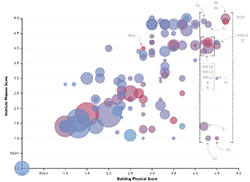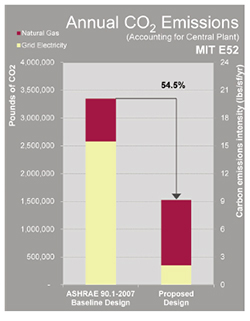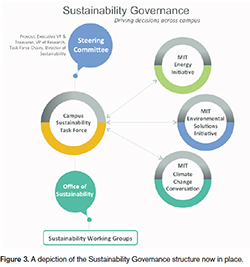
| Vol.
XXVII No.
5 May / June 2015 |
| contents |
| Printable Version |
Launching a Next Generation
Sustainability Framework at MIT
MIT fosters a rich network of departments and initiatives working toward advancing sustainability on campus, locally, and around the world at all levels and scales. Students, staff, faculty, and a multitude of institutional and community-based partners collaborate across disciplines to discover innovative solutions that improve the well-being of people and the environment. Research related to sustainability spans the development of clean energy systems, to the optimization of urban food production, to the design of smart mobility systems.
Many of the urgent issues our students, researchers, and faculty are grappling with have relevancy to the day-to-day and long-term decision-making of a dense, urban campus defined by the Charles River and its ecosystem. This synergy among our education, research, and how we manage our campus operations has the potential to profoundly impact the sustainability of our campus and, in turn, systems throughout the world.
Building on the momentum of the past and with an influx of new partners and projects, it is an opportune moment at MIT to take sustainability innovation to scale on campus, locally, and beyond. We are now positioned to ask ourselves: How can MIT become a game-changing force for campus sustainability in the twenty-first century?
MIT has a history of prioritizing the sustainability of its buildings and the study, research, and implementation of transformative energy systems. The Campus Energy Taskforce and the MIT Energy Initiative (both established in 2006) and a commitment to constructing and renovating LEED (Leadership in Energy and Environmental Design) certified buildings on campus have set a strong foundation for current and future efforts. Most significantly, the Institute has embarked on the initial phases of a campus renewal program that will continue through 2030. Plans for renewal and expansion of the Central Utilities Plant align our campus energy generation, distribution, and building power usage in support of an ever-expanded mission – one that is “right-sized” to the natural resource constraints of a changing economy and climate and to the needs of a first-class research campus.
In the last two years, MIT has exponentially increased its capacity to drive sustainable solutions. The Office of Sustainability was established in the summer of 2013, followed by the MIT Environmental Solutions Initiative that fall. A year later, President Reif called for an exploration into “how the MIT community – through education, research and campus engagement – can constructively move the global and national agendas forward” on effective climate change mitigation, thereby launching the MIT Conversation on Climate Change. At the city level, Cambridge is advancing toward building energy use disclosure, understanding net zero building emissions, exploring an EcoDistrict in Kendall Square, and climate action planning. The Office is now positioned as a connecting force in this network of sustainability-related initiatives.
Calling for a Next Generation Sustainability Framework at MIT
The creation of an Office of Sustainability, under the leadership of the Executive Vice President and Treasurer’s Office, has given MIT the unique opportunity to redefine the field of campus sustainability. MIT’s commitment to applied research, technology, and policy innovation combined with lessons from peer institutions, now enables us to frame a “next generation” approach to campus sustainability that moves the entire field forward.
A core component of a next generation approach is the creation of a decision-making platform for the campus that is founded on systems thinking and powered by responsive, robust data and metrics. The interactions between human health, environmental quality, and fiscal responsibility, are increasingly complex. Even routine decisions become complicated when we take into account the interconnectedness of the systems that sustain us. How do our decisions about campus design impact the Charles River Watershed? What is the relationship between the materials that flow into campus via procurement systems and those that flow out via waste management? A commitment to sustainability allows us to consider near- and long-term fiscal, environmental, and human health impacts when making decisions, and we are currently building the capacity to create this process.
By developing tools like those shown in Figure 1, we are working across infrastructure investments and decision-making to ensure sustainability is inherent – not additional – to the way we operate our campus. Sustainability and energy use are now an integral part of ongoing discussions, with new emphasis on downscaling inefficiency in buildings, and scaling up our ability to operate a campus on the cutting edge of sustainable infrastructure. A comprehensive operational greenhouse gas inventory completed for FY2014, also gives us new data to help manage, plan, and prepare to reduce our contribution to climate change.

and Energy Intensity
(click on image to enlarge)

(click on image to enlarge)
| Back to top |
Building Capacity for a Sustainable Future
In the fall of 2014, we launched our first set of Sustainability Working Groups with systems thinking at their core, charged with re-examining the management of the campus and recommending strategies the Institute can take to advance sustainability to its highest potential. The first set of priorities includes: Sustainable Design and Construction, Green Labs, Materials Management, and Stormwater and Land Management. The recommendations developed by these Working Groups this spring will seek to align campus operations along a core set of sustainability principles, setting a strong foundation for rigorous and innovative Institute-wide goal-setting, measurement and verification, and implementation strategies.
In March 2015, “SustainabilityConnect 2015” convened the staff, faculty, and administrative Working Group participants and sponsors, as well as four additional groups and committees tasked with developing related recommendations, including the Climate Change Conversation. The first event of its kind at MIT, this forum combined presentations from topical experts with concrete working sessions covering topics such as climate vulnerability in Cambridge and the power of innovation to transform campus sustainability. The purpose of the day was to set a foundation for the development of an integrated and innovative set of recommendations this spring. New and old colleagues came together – over 125 students, staff, and faculty were in attendance.
During one of the event’s talks, Henry “Jake” Jacoby, Professor Emeritus of Management and member of the Climate Conversation Committee said: “We see ourselves as a catalyst for change, and there are a lot of people in the world looking at what we do.” If the Institute can find solutions on campus that are scalable and replicable, he said, “We can have an influence.” This recognition that we can have a global impact through our campus actions is driving the working groups forward as they craft their next generation recommendations.
The recommendations that the Working Groups develop this spring – and all recommendations from future working groups – will head to the newly established Campus Sustainability Task Force, made up of students, staff, and faculty from the five Schools. The Task Force will work under the auspices of the Campus Sustainability Steering Committee to shape the vision and plan of action for campus sustainability at MIT.

(click on image to enlarge)
The Task Force, working with the Office of Sustainability, will connect the leadership of the MIT Energy Initiative, MIT Environmental Initiative, and Committee on the MIT Climate Change Conversation. Its membership will enable the MIT community – faculty, students, and staff from across the Schools and interdisciplinary laboratories – to set a vision for MIT. The Task Force commenced in April 2015 and will regularly submit recommendations to the Campus Sustainability Steering Committee for review and endorsement.
Harnessing the power of the collective toward a sustainable future at MIT
MIT is well positioned to excel in a next generation approach to campus sustainability given its collaborative fabric of researchers, entrepreneurs, inventors, and community partners. We are poised to transform the campus and its surroundings into a scalable laboratory, in which to devise, pilot, implement and evaluate the sustainable urban strategies of today and the emerging next generation strategies for tomorrow.
As a community, we now need to determine together which game-changing questions to pursue. How can we connect the campus to the cutting edge research on solar energy and hydrocarbon production, on global systems and nanostructured materials? MIT is positioned to take the lead in this arena and build a new narrative.
| Back to top | |
| Send your comments |
| home this issue archives editorial board contact us faculty website |